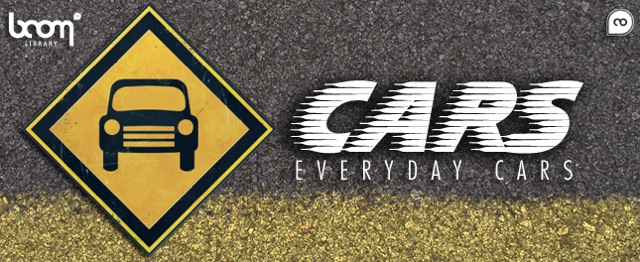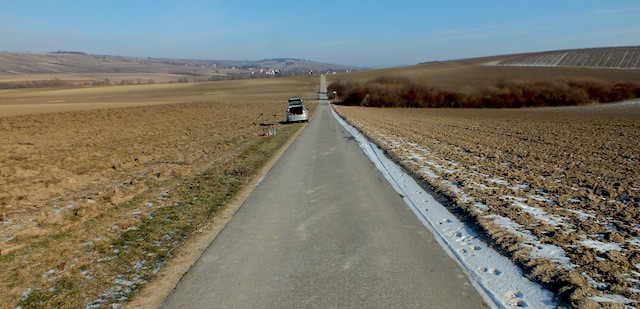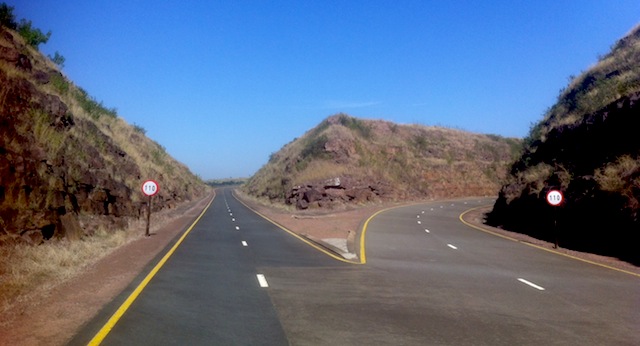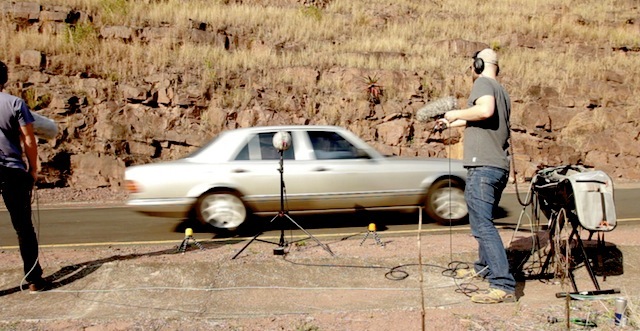
(Written by Tristan Horton and Axel Rohrbach of Boom Library)
At Boom Library we like to take a category of sound and then completely go to town on it. A Cars library has been in on our hit-list for some time, but there have been so many car sounds recorded in the past – how could we push this even further, (beyond the obvious advantages of high-definition 24bit/96kHZ recording), so that it would stand apart and fill a gap that was under catered for? The answer was fairly obvious. The (unfortunate) truth is most of us don’t drive around in vintage V8 muscle cars or Ferraris from the future. A lot of life happens in normal cars, mostly built in the last 2 decades.
So we set our sights on capturing a wide range of daily cars, with an assortment of engines, body shapes, age and milage.

But first things first: Location, Location, Location. We are incredibly focused on the usability and flexibility of our libraries (some might say pathologically) so we aimed to extract the widest possible pallet of sound from the vehicles. It’s pretty easy to record a car screaming past at 100km/h – just set up the mics and let the car drown out most of the background noise – but we knew a comprehensive car library would have to include low speed driving. So we needed a super quiet location to get super clean recordings.
The first set of cars were recorded in Europe during winter (2011/2012). The temperature was down to minus 20°C out in the field, which was good because only sound designers are silly enough to be out in those conditions. No birds, no pedestrians, no field workers. We were freezing like never before but getting great recordings. One downside (apart from frozen toes) is that the battery life is extremely limited under those conditions. The recordings took place near Engelstadt (49.910977,8.093008) on a quiet public road – this limited the recordings to daytimes with no traffic . The first set of cars included a VW Polo 1.6 (1996), a Peugeot 307 SW (2004), an Audi A3 (2007) and a BMW 1 series (2009). A good start but we knew we had more to do.
 

By the time we went back to record more cars we found the temperature had gone up and birds, pedestrians, dogs, cyclists and field workers started to appear – not ideal. So we decided to move the recording to South Africa where winter had just started.

Fortunately, there is an amazing private test track hidden in the middle of a sugar cane estate in rural Kwa-Zulu Natal (South Africa)( 29°50’58.13″S 30°34’10.00″E). A perfectly straight, perfectly level 3km high speed track. Its rural isolation and favorable geological layout make it a recordist’s dream, and while Europe was alive with the sounds of spring, in South Africa nature was starting to quiet down. We hired the track for 2 days and assembled a set of cars that included a 2011 A5 V6 TDI, a 1.2 Fiat Panda (2011), a BWM 318i (1991), a Subaru Forrester (2006) (Flat-4 Boxer) and a Mercedes Benz 300SE (1991) (Straight-6). (The trunk of the 300SE could easily fit several bodies, if you were so inclined).

We like new cars but we are also fascinated how cars develop their own sound character after several thousand kilometers (in some cases several hundred thousand kilometers) One of our favorite cars was a 1991 BMW 318i with about 250.000 km on it, the engine was tired and almost didn’t start the morning we took it to the track. Something about its worn out engine having to really strain hard made it sound exciting.
 

Armed with a suitably lengthy excel spreadsheet (always remember the clipboard) we set about completing our library, thankfully in temperatures above freezing.
We used Sound Devices recorders (744t plus 442 and a C-linked 702 for 6 channels) recording at 24bit/96k. The Sound Devices units really let you hustle and get on with recording. They allowed the team to be flexible and work very quickly with the many cars and different setups.
A key feature of this library is its multiple perspectives. To give us the greatest flexibility to choose what works best in post production, we used a four-to-six microphone setup for drive-bys. A spaced pair of omni DPA mics really close to the cars, a Sennheiser MKH8050/MKH30 M/S rig on some cars plus two shot-gun mics, following the cars in and out. One of the shotguns focused on the engine, the other on the exhaust. We were able to (cleanly) get amazingly long approaches and aways.
We used a 4-channel setup for onboard driving recordings: an interior stereo setup and DPA4061s both on the exhaust as well as in the engine bay. The DPAs high SPL handling and ease of attachment made these little guys perfect for that task (always bring extra duct tape… you will need it!). Their wide frequency response and excellent dynamic range captured all the detail of the engine and exhaust really well.
We recorded loop-able static driving, revving, acceleration and braking at different intensities; every possible scenario for every sound discipline.
Handling or Foley sounds were a particularly interesting and fairly time consuming process. Using a Sennheiser M/S (SA) or a Sennheiser 8040 XY (GER) rig and a SD 702 / SD 744T, we systematically worked our way through each car and if something made a noise we recorded it. The real challenge is to remove the recordist from the recordings. Until we master telekinesis, one of the best pieces of gear for doing this is a Goby Gorilla Pod. Its low profile and flexible legs lets us easily get the mic into the right position within the tight confines of the cars, allowing the recordist to concentrate on the performance and controlling any cloth / movement noise. Plus it means only one air breather inside the car.
To make the library as flexible as possible, we recorded multiple takes of every handling sound, different speeds, varying dynamics and intensities, and, where appropriate, interior and exterior perspectives.

To maintain the high standards of usability, comprehensiveness and consistency, Excel becomes a sound designer’s secret weapon. We have worked hard to develop the structures within our workflow that allow us to stay focused and be efficient with our recordings. Essential for the success of a multi-mic, multi-vehicle, multi-session and multi-hemispherical library.
Credits
- Executive Producer: Axel Rohrbach
- Sound Recordists: Tristan Horton, Felix Diekhake, Oliver Machin
- Assistant Sound Recordists: Vlad Buzdugan, Pierre Langer
- Drivers: Jimmy Reynolds, Benedikt Huster, Felix Diekhake
- Sound Editors: Tristan Horton, David Osternacher
CARS
- Mercedes Benz 300SE 3.0 (1991) – gasoline
- BMW 318i 1.8 (1991) – gasoline
- VW Polo 6N1 (1996) – gasoline
- Peugeot 307 SW (2004) – gasoline
- Subaru Forester 2.5 XS (2006) – gasoline
- Opel Corsa C 1.4 (2007) – gasoline
- Audi A3 (2007) – gasoline
- BMW 1 series (2009) – gasoline
- Fiat Panda 1.2 (2011) – gasoline
[vimeo]http://vimeo.com/44099820[/vimeo]
Cool, we needed more of those European models. Thx
Kudos for the great work :D .
Nice article and video! Looking forward to getting and using the sounds :)
I love the in-depth details about the recording setup and location scouting in this article; BOOM has got an awesome system down that I look up to as a sound designer collecting my own sounds. For my first set of serious car recordings I went out at 3am to avoid all suburb ambience. Still dealt with minor crickets but able to remedy this by strategic mic placement. That isolated track in Africa indeed seems like a dream!